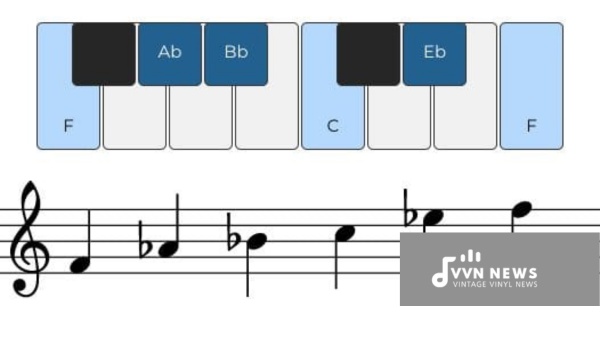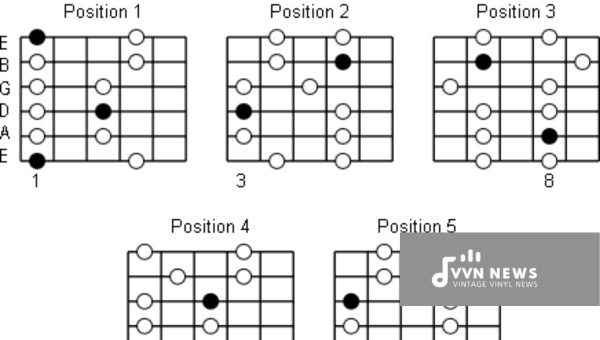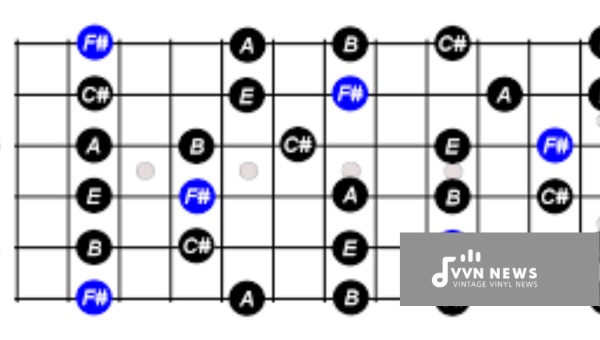When it comes to the world of music, scales are foundational stepping stones we build melodies and harmonies.
Today, I want to share my fascination with a particular one – the F minor pentatonic scale.
This remarkable scale has swept through decades and genres, captivating listeners with its distinctive sound that is as versatile as it is profound.
The F minor pentatonic scale, while simple in its composition, can be part of a broader musical narrative that conveys immense emotion and depth.
Whether utilized in bluesy improvisations or soulful ballads, this unassuming collection of notes can truly transform a piece and add that extra layer of musical depth we often seek – from the beginner’s practice room to the professional concert hall.
What is the F Minor Pentatonic Scale?
The F Minor Pentatonic Scale is, quite simply, a 5-note scale that doesn’t include the 2nd and 6th degrees of the typical scale.
It consists of the notes: F (the root), Ab (the minor third), Bb (the fourth), C (the fifth), and Eb (the minor seventh).
This melodic sequence carries a rich, expressive capacity; it’s commonly found in genres like blues, rock, and jazz. Its structure enables musicians to convey powerful emotions ranging from sorrow to elation.
Whether you’re strumming a guitar or striking piano keys, this distinct scale adds an enticing depth to your music.
Steps to Form the F Minor Pentatonic Scale

Playing the F minor pentatonic scale is a straightforward process, once you know its structure.
Its pattern consists of five notes – F, Ab, Bb, C, and Eb.
Here’s how you form an F Minor Pentatonic scale:
- Start at the root note – F: This is your base point, your starting and finishing note.
- Move up a Minor 3rd to Ab: The term ‘Minor 3rd’ refers to a specific interval in music theory. In this context, it’s just three half steps (or three frets on a guitar) above F.
- Move up a Whole step to Bb: ‘Whole step’ also refers to an interval and means moving up two half steps from where you are now – at A flat or four full steps from your starting note F.
- Jump another Whole step to C: Similar to the previous move, move up another whole step which lands you on C.
- Move up a Minor 3rd to Eb: The final move brings us back up by just three half steps or one minor 3rd interval from C.
By following these steps carefully, you can navigate your way around any instrument via the haunting tones of the F minor pentatonic scale.
Also Read: B Minor Chords [Maximize Your Musical Skills Today]
Shapes of the F Minor Pentatonic Scale
When we’re talking about scales, especially the F minor pentatonic scale on a guitar, shapes are key components to be aware of.
These shapes, or patterns, are visual representations on the fretboard that will guide your fingers to hit the right notes every time.
Shape 1
This is often referred to as the “home box shape.” It starts on fret 1 for an F minor and includes two notes per string across all six strings.
This shape is generally one of the first that guitarists familiarize themselves with due to its simplicity, but it’s essential not to limit yourself to just this one shape.
Shape 2
Often considered next in complexity is “shape 2.” Starting from the fourth fret (assuming we’re still in F minor), this pattern asks you to stretch a little more than the first shape.
It’s characterized by having three notes on two out of six strings.
Shape 3
The third shape takes place starting from fret number six. Its unique characteristic is having three notes again on two strings but arranged distinctively from its predecessor.
Shape 4
Moving up from our shape 3, you would begin shape 4 at fret number eight.
This pattern is loved for its similarity to shape 1, except it’s slightly higher. Therefore, many find this an easy transition from learning shape 1.
Shape 5
Finally, you have shape 5, which begins at fret number eleven and offers a slightly more complex structure than previous shapes but can wield rewarding results when mastered.
It’s crucial to remember that these shapes form the framework of your scale on guitar: take time with each one, gradually finding fluidity and confidence before moving on to the next pattern.
All these shapes interlock and are repeated across the fretboard, providing the toolbox for your improvisation skills to shine.
What’s the corresponding Major and minor scale for the F Minor Pentatonic Scale?

A peculiar characteristic of the F minor pentatonic scale is its relationship with the major scale.
Often, a major scale is treated as the ‘parent’ to a related minor scale. For our F minor pentatonic scale, the corresponding major counterpart would be the Ab major pentatonic.
The Ab major pentatonic and F minor pentatonic share the same notes but have different tonal centers.
It means they deliver unique sounds even with their shared elements. Here’s a brief look:
Ab Major Pentatonic:
Ab – Bb – C – Eb – F
F Minor Pentatonic:
F – Ab – Bb – C – Eb
At first glance, this might seem like a simple switch of note orders. But really, it conjures an entirely different sound and mood.
Moreover, our noteworthy F minor pentatonic also corresponds with another crucial element in music theory: The natural D# (or Eb) minor scale.
This one exhibits more complexity yet gives rise to plenty more harmonious opportunities.
Also Read: C Sharp Minor Chords [Simple Guide For Aspiring Musicians]
How to Master the F Minor Pentatonic Scale with Backing Tracks
Practicing the F minor pentatonic scale with backing tracks can significantly heighten your musical prowess. Here’s an approach you could adopt:
1. Start slow: Regardless of proficiency, every musician benefits from an unhurried pace in mastering new scales or techniques. Play along with slow-tempo tracks ensuring each note rings clear while maintaining a consistent rhythm.
2. Increase the tempo: Gradually quicken your pace, ensuring precision is not compromised in favor of speed. Experiment with different speeds to broaden your capabilities.
3. Play along with backing tracks: Online platforms have a myriad of backing tracks in the F minor pentatonic that will challenge and inspire you. Websites like Jamtrackcentral provide a rich selection of music across genres.
4. Explore improvisation: Lastly, indulge in some improvisation! Playing along with accompaniment isn’t about perfect imitation; let your creativity flow freely.
How does ear training help with the F Minor Pentatonic Scale?

Mastering the F minor pentatonic scale involves more than just memorizing finger positions; it includes developing an intimate sonic relationship with the scale.
This is where ear training springs into action. It allows you to form a mental representation of these tones, helping you synchronize what you hear with what you play.
Recognize Patterns
Firstly, ear training assists in recognizing patterns within the F minor pentatonic scale.
The five-note structure gives it a particular melodic flavor that’s easily identifiable once you’ve trained your ear.
Internalize Notes and Intervals
Honing in on each note’s sound within the scale is another advantage provided by ear training.
Realizing how an F note, for instance, contrasts with a C sharp creates an insightful narrative around each tonal relationship.
Finally, identifying larger structures like triads or chords translates to quicker recognition during real-time playing.
Sharpening your musical ear aids in memorizing and responding to harmonic structures common within songs, when using scales such as F Minor Pentatonic.
Improve Improvisation Skills
Arguably most beneficial is how ear training boosts improvisation abilities.
Many popular genres leverage the F minor pentatonic scale extensively in soloing and improvised sections.
Owning a well-trained ear keeps up with on-the-fly decision-making when jamming or engaging in musical dialogues.
Incorporating ear training into practice routines can fast-track your mastery and artistic expression of intriguing scales like the F minor pentatonic – creating music becomes not just about plucking strings or pressing keys, but about transforming the sounds we hear into the language we speak.
Songs Utilizing the F Minor Pentatonic Scale
When it comes to music, the F minor pentatonic scale leaves its mark almost everywhere.
Its five-note sequence brings a unique flavor to numerous songs across various genres.
To fully appreciate its capacity, let’s delve into some of the tracks that effectively utilize this scale.
“Hey Joe” by Jimi Hendrix
As an emblem of classic rock, Jimi Hendrix was well known for his extensive use of the minor pentatonic scale.
One such notable instance is in his version of ‘Hey Joe’, where parts of the solo are played along the F minor pentatonic.
This soulful tune is quite illustrative of how expressive and fluid this scale can be when used wisely.
“Stairway to Heaven” by Led Zeppelin
Unfailing in its popularity despite the passing decades, ‘Stairway to Heaven’ offers an excellent example for those curious about the F minor pentatonic.
While not entirely in F minor pentatonic throughout, sections show how seamlessly this scale integrates into more complex compositions, adding rich tonal dimensions to the melody.
“Thriller” by Michael Jackson
Even pop music has felt the touch of this versatile scale. The musical icon, Michael Jackson’s hit song ‘Thriller’, showcases how it can be utilized beyond rock and blues genres.
The song demonstrates how these simple notes can add compelling hooks within a groovy pop context.
Every time you listen to these iconic songs remember they hold lessons in musical theory like our beloved F minor pentatonic!
Researching different uses can also broaden your approach – whether you have songwriting aspirations or simply want to try playing different tunes on your instrument!
Also Read: D Minor Chords [Step By Step Guide For Guitarists]
FAQs About The F Minor Pentatonic Scale
How do you construct the F Minor Pentatonic Scale?
It’s quite simple to construct. You start on F and follow the pattern: minor 3rd, whole step, whole step, minor 3rd, and a whole step.
Why is the F Minor Pentatonic scale popular in blues and rock music?
This scale is popular because it provides some of the richest-sounding notes and possibilities for expressive bends due to its combination of tones.
Can I solo using just the F Minor Pentatonic Scale?
Absolutely! It’s a great scale for soloing, particularly in genres like blues and rock.
What is a good way to practice my fingering on this scale?
A recommended method is to use a guitar metronome while playing through the various positions of this scale up and down the fretboard.
Can you name any songs that use the F minor pentatonic scale extensively?
One such song is Eric Clapton’s ‘Old Love.’ This tune exemplifies how musicians can effectively utilize this remarkable scale within their works.
Conclusion
In closing, the F minor pentatonic scale is an integral tool for any aspiring musician.
The richness of its tone and the range of melodies it can produce are truly remarkable, offering unlimited possibilities for musical expression.
So, don’t be afraid to get hands-on with your instrument or even play around experimentally with some tunes you love.
You’ll be amazed by the incredible sounds that this relatively simple scale can generate!








